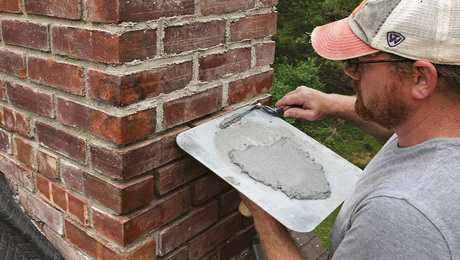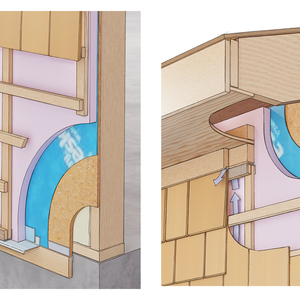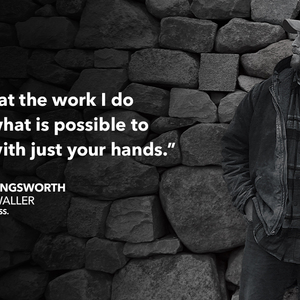Well, it’s a pretty boring night here so thought I’d stir up some trouble.
Regarding wire nuts, what is the RIGHT way to make a connection with wire nuts? Twist the wires, or not?
I was taught to ALWAYS twist the wires together first then nut it. I’ve also taken apart more than one old connection where the wires were not twisted, but bunched together and then nutted…and….along those same lines I’ve actually had untwisted wires come out of a nut on a fair number of cases (and I didn’t touch it, it came out as a result of shoving wires back in the box) that was supposedly a good connection.
I bought a box of wire nuts today and for the first time read the box and it said “no pretwisting necessary” and to gather the ends and nut it. I thought that strange given a twist connection seems much more positive and stronger than to gather ends together and nutting them.
Edited 7/11/2004 12:17 am ET by Pyrotechie



















Replies
These connectors, wirenuts, are rated and tested without the twist so it is not required.
On the other hand I twist because I believe that it increases the mechanical strength of the connection and may increase the contact area between conductors making a slightly better electrical connection.
I think that the greatest benefit to twisting the connection prior to installing a wirenut is that it increases the care and attention taken in making the connection. Essentially the connection is completely made and inspected. Only then the wirenut firmly twisted on locking everything in place and insulating the joint. This alone IMHO tends to increase the probable effectiveness and reliability of the connection.
It is the way I learned and it is what I teach and expect from helpers and apprentices. So far it seems to have served me well. I also note that a large proportion of the connections I have seen fail have not been twisted. Possibly this is more evidence of inexperienced or careless electricians than an inferior technique.
>>I think that the greatest benefit to twisting the connection prior to installing a wirenut is that it increases the care and attention taken in making the connection. Essentially the connection is completely made and inspected. Only then the wirenut firmly twisted on locking everything in place and insulating the joint. This alone IMHO tends to increase the probable effectiveness and reliability of the connection.
FWIW, whenever I open a box and find a really neat job, I'll point it out to the clients and tell them "I think it is a really good sign when we can see the electrician had a little bit of obsessive-compulive disorder. It tells us the electrician is really taking care to do an excellant job and significantly reduces the chances he or she made mistakes in one of the many places we don't open to inspect."
"It is as hard for the good to suspect evil, as it is for the bad to suspect good."
-- Marcus Tullius Cicero, statesman, orator, writer (106-43 BCE)
Twist the wires together, to the right, cut the ends off cleanly and insulate with the wire cap...
Life is not a journey to the grave with the intention of arriving safely in a pretty and well preserved body, but rather to skid in broadside, thoroughly used up, totally worn out, and loudly proclaiming....
WOW!!! What a Ride!
Twist. DanT
I do not twist, twisting solid core wire will cause the wire to become brittle and break. The new wire caps do not required that they be twisted. This will also save time working in the small boxes. To be honest it properly does not matter if twisted or not.
Twist the spliff, or wire nut.
Who Dares Wins.
I twist and make sure it's a nice neat even twist.
"I've actually had untwisted wires come out of a nut..."
So have I - In the "spec house from hell".
A couple of things mysteriously quit working. I looked and looked, trying to figure out what was wrong. When I finally did, it was a single hot wire that wasn't twisted together with the wires going out to the circuits that it was feeding. It had simply slipped out of the wire nut.
That pretty much sold me. I spent more time troubleshooting that one circuit than the electrician saved by NOT twisting the wires in the entire house.
To become a father is not hard; to be a father is, however.
Make sure you let him know that to. It's the only way that he'll know that his procedure needs improving.Who Dares Wins.
Make sure you let him know that to. It's the only way that he'll know that his procedure needs improving
Thats a nice way of putting it. I would definately let him know about his "assembling procedure" :>)
Darkworksite4:
El americano pasado hacia fuera ase la bandera
I will usually strip about 1" to 1 1/2 " of wire then twist and cut to about 3/4" lenght then I use a wire nut and wrap the nut with tape. If its going on a device outlet ect. Ill wrap the outlet with tape also.
Darkworksite4:
El americano pasado hacia fuera ase la bandera
not house wireing, but my dad would dip nutted splices on the tractor in Plasti-dip..ya know that stuff for tool handles?
We had to put a new wireing harness in...what a PITA.
Spheramid Enterprises Architectural Woodworks
Repairs, Remodeling, Restorations.
How many people also wrap the wire nuts with elec tape? Do people still solder??
-m2akita
Speaking of tape ... my sparky puts two wraps around each outlet and switch to cover the terminal screws.
Whenever you are asked if you can do a job, tell'em "Certainly, I can!" Then get busy and find out how to do it. T. Roosevelt
I do that to. It's a nice little precaution and if you ever have to work on it hot it's nice also.Who Dares Wins.
Right--I like it when the previous guy wrapped electrical tape around the thing so when I'm fooling with it and accidentally touch the screw to the box (if box is metal)I don't get a shock. I heard though that you shouldn't wrap tape around the wirenuts because it can hide bad things. Some people tape over the wirenuts because they stripped the insulatrion too far back. Better to cut the wire off to the right length.
Last FAA radar site I worked on all the wirenuts had to be taped. Something about it keeping the nut from vibrating off and preventing anything from getting up under the skirt and causing a short. I guess.
They said do it so we did. No major pain.
Interestingly the building was designed to handle a 30-06 because it was rural Florida. Florida boys can't shoot for beans when they get a bit of bud and beer in them. River rock over reinforced concrete. Even the back up generators fuel tank was pretty cool. looked like 3/16" steel inner and outer tank separated by about 3" and this space filled with concrete.
Cad Welding in the rain. Oh joy.
Maybe that's a good argument for keeping those semi-auto sniper rifles that use .50 cal machine gun cartridges out of civilian hands! Hard to stop those bullets. (Normally my idea of gun control is to hit what you aim at.)
> Do people still solder??
Yes, I do. Twist first for a sound mechanical connection. I use the Weller gun, not the traditional hot pot. For permanent low resistance, it's still the best.
-- J.S.
There is no way I could solder all the connections, and the occasional re-wiring of a box or swith or light would be a complete pain in the hindquarters.
I think that is a mistake.Regards,
Boris
"Sir, I may be drunk, but you're crazy, and I'll be sober tomorrow" -- WC Fields, "Its a Gift" 1934
Since soldering came up:
There are some things maybe one does on their own house that would price you out of the market elsewhere. Own house (32 yrs old) has never had a loose joint or a bad outlet. All joints are ideal 410/415 crimps, all 12 awg - - wire twisted before crimps, soldered w/ 63/37 after the crimp, then cap put on. There is valid reliability data that shows stranded wire crimps are more reliable without the solder, but most of the wire is solid.
Here is one other technique never mentioned that I'll bet maybe nobody else has done -- it would break the bank for paid labor -- but, used it on my own house. All the outlets except the last in the string have no wire breaks! That's right, all the wire was fished thru every box and the wire looped and stripped without cutting and wrapped under the screw posts of Hubble spec grade outlets. A few places where there is a tee the 3rd wire pair is into 8 hole clamping hubbles.
"All the outlets except the last in the string have no wire breaks! That's right, all the wire was fished thru every box and the wire looped and stripped without cutting and wrapped under the screw posts..."
I just saw this somewhere this spring. I can't remember what job that was, but I was impressed. Of course, I didn't leave it like that by the time I was done with it (at least I don't think I did...can't be sure since I don't remember what job it was!).
Rich Beckman
Another day, another tool.
My 1957 vintage house in El Sobrante, CA, is wired like that with a continuous wire stripped at each outlet. Unfortunately, the electrician did not leave enough slack, so it is a real struggle to replace outlets. The house also has 60amp, service with no 240v and has, if I remember correctly, 7 circuits for the 3 bedroom, 1 1/2 bath, 1100 sq ft house. This was part of a small subdivision, so I assume they are all done the same.
Edited 7/13/2004 12:15 am ET by CaseyR
> There is valid reliability data that shows stranded wire crimps are more reliable without the solder,
I found the same thing with tinning stranded wire and putting it under a screw. Several years later, those connections started heating up.
-- J.S.
Twist. And shout.
At first I just twisted on the wire nuts. Then I started using a tool like the 3-M one [red]. This can over twist if you're not careful. Then, on occasion, dis-assembling some of these splices, it was noticed that sometimes the wires were not twisted inside but were straight. Not using the 3-M tool mind you.
Sometimes, if you have four wires say, three of the wires will spiral around the fourth wire which remains straight, doesn't contact the spring of the wire nut and can easily slip out.
The instructions may say that pre-twisting is not necessary but this is a minimum. It is permissable [usually] to exceed the minimum. Any time saved by not pre-twisting is more than offset ny the trouble shooting involved with a future failure. In doing schools, it is required, at least by the competant contractor, if not by the specs.
Wrapping the receptacles with black phase tape is a good idea. 1¢ worth of tape to prevent a potential shock.
Taping the wire nuts shouldn't be necessary. Make sure all the bare, stripped wire is under the pretty colored apron of the wire nut.
And don't use the backstab receptacles.
~Peter
Never have twisted the wires together (since '67), but always used 3M scotchlocks (which have a more shallow angle on the screw inside)--don't tend to "pop off" like the wing nuts. Have seen those pop off or ready to, so can understand the call for tape. Now I really like the combination Red/Yellow 3M scotchlocks (best of both worlds).
The exception to this procedure is stranded fixture wire to solid #12. Strip the stranded about 1 in and spiral it clockwise around the solid (or one of the solids).
Was told to not twist (from the start) given that the inner spring puts the same pressure on all of the untwisted wires. (A twisted bunch of wires can still end up with a loose one with the spring mechanically unable to overcome.)
The untwisted system is easier to follow on a wiring change.
A twisted bunch is more bulky and takes a larger scotchlock.
I'm obsessive about carefull and neat wiring by the way and it seems that care and attention to detail will make either system work.
I don't pretwist the wires, but I screw the wirenut until I have a full twist in the wires outside the nut. This way, I know that the nut is as tight as it's going to get, and even if the nut threads don't grab all the wires, none of them can slip out.
SamT
not too long ago, we discussed the "right way" to twist wires..remember the post about a guy who's dad or dadin law said CCW was correct?
anyway, I was looking for the screw driver that had the hole in the handle..for the nut to be twisted.
Someone posted a link to it..wasit you? Mebbe IDEAL tools?
If yer twistin THAT tite ( all day) ya gotta have one of them..saves a ton of finger flesh for better things.
Spheramid Enterprises Architectural Woodworks
Repairs, Remodeling, Restorations.
Not me, bud. At least I think not me. I always had to do it by hand. 1 or 2 connections a month or so. Usually.
Whole house copper plumbing can give ya some good sized wrists, too, ya know? I want an electric brush turner and an inside out flapper sander. And something to hold opn to the inside of them little 1" long nipples. Pipe nipples ya perv! I knows hows to hold dem udder ones.
SamT
I got one of those *pipe* nerple holders..fer real. it's a reamer with a spring coil blade..it works. Or else try a internal pipe wrench..
Spheramid Enterprises Architectural Woodworks
Repairs, Remodeling, Restorations.
SamT,
These 1/4" dive copper brushes are pretty sweet, http://www.cleanfit.com/ft-cb.htm.
Twist the wires CW, same direction as the nut. I've seen inspectors flag jobs that used tape in addition to nuts. I think because it would hide bad technique - bare wire past the nut.
OOooooh! the Power Duece
View ImagePower-Deuce BrushThe Power-Deuce is a combination fitting brush and O. D. tube cleaning brush exclusively from Mill-Rose.
I need a new tool.
Hehehe, I took my boy with me shopping for a tool one time, later, in the toy store he says "Daddy, I need a new toy."
SamT
Did you guys know that the "wingless" yellow wire nuts fit real nice inside 1/2" copper pipe?
get a 5-6' piece of pipe & some wire nuts and a blow nozzle for the compressor and you can launch those suckers about 100 yards!!
They will leave a good dimple in SR or a nasty bruise on your butt.
I heard this from a friend BTW.Mr T
Happiness is a cold wet nose
Life is is never to busy to stop and pet the Doggies!!
I wire like I was taught.
Stretch out the wires from the box, about 3 inches. Cut them off at same length. Strip to same length. Twist with Linesman Piers (about the only use for them now). Attach wire nut. Twist Wire Nut Taut. If the connection is a neutral, white tape over nut; if it is a hot, then black tape over nut. If the connection is switched, red tape over the nut. If the connection is something else (traveler), then blue tape over the nut. Fold the wires in half, and tuck them neatly in the box.
I also label connections, and take great pains to insure than a white neutral type wire when being used as a hot, or visa versa, is taped to the appropriate color all the way down as far as I can get. (white neutral, black hot, red switched, blue other).
But I am way too anal, and I know that.
Regards,
Boris
"Sir, I may be drunk, but you're crazy, and I'll be sober tomorrow" -- WC Fields, "Its a Gift" 1934
Do you label the wires? If so, what's the best way you've found? When I was doing network wiring, we used a piece of numbered tape at each end of the network wire (same number at each end.) Do you do something similar? I was thinking of doing something similar with the wiring I will be putting into my shop, but something more descriptive might be better for whoever comes after me.
Let say I am wiring a switch. Comming into the swith will be a black hot wire and going out will be a red switched leg.
I take a file folder lable and with a Sharpie write on both the left and right sides of it "Hot lead from ____________" (where ever its coming from, be it the main panel or perhaps a junction box in the basement, whatever). The outgoing red switched leg will say "Switched lead to ceiling light" or wherever it is going.
We like to use "switch boxes" in other words, after the switch box, the switched leg does not go directly to the appliance, box or outlet. Instead it goes to another box in the attic or basement, or some accessible area, where all the applicances being run by that switch are gathered. This avoids tracing wires.
When wiring junction boxes, it is often helpfull to have a mailing label or other adhesive lable on the inside of the lid, which explains what the heck this box is, what it does, where stuff comes from and where it goes. A typical box in an attic above a BR might say: "NE Bedroom outlets" "Hot Lead Directly from Main Panel" or something like that.Regards,
Boris
"Sir, I may be drunk, but you're crazy, and I'll be sober tomorrow" -- WC Fields, "Its a Gift" 1934